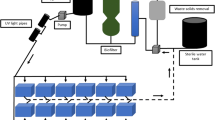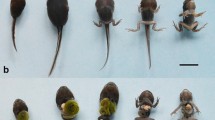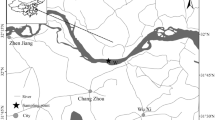Abstract
During evolution of animals, their co-evolution with bacteria has generally been ignored. Recent studies have provided evidences that the symbiotic bacteria in the animal gut can either be essential or contributing to the plasticity of the host. The Crustacea includes crab, crayfish, lobster, and shrimp and represents the second largest subphylum on the planet. Although there are already studies investigating the intestinal bacterial communities in crustaceans, none of them has examined the microbiota in different parts of the digestive system during the gonad development of the host. Here, we utilized a new shrimp model Neocaridina denticulata and sequenced the 16S rRNA using the Ion Torrent platform to survey the bacterial populations colonizing the hepatopancreas, foregut, and intestine, including midgut and hindgut, of the early, mid, and late ovarian maturation stages of the shrimp. The predominant bacteria phylum was found to be Proteobacteria, with more than 80 % reads from the gut flora at the early gonad development belonged to a Coxiella-type bacterium. Distinct bacterial communities can be detected between the hepatopancreas and gut, although no significant difference could be revealed between the different regions of the gut investigated. Surprisingly, during the gonad development, bacterial diversity changed rapidly in the gut but not the hepatopancreas. This study provides the first evidence that microbiota modified differentially in specific regions of the digestive tract during gonadal development of crustaceans.





Similar content being viewed by others
References
Adachi K, Toriyama K, Azekura T, Morioka K, Tongnunui P, Ikejima K (2012) Potent cellulase activity in the hepatopancreas of mangrove crabs. Fish Sci 78:1309–1314
Andreotti R, Pérez de León AA, Dowd SE, Guerrero FD, Bendele KG, Scoles GA (2011) Assessment of bacterial diversity in the cattle tick Rhipicephalus (Boophilus) microplus through tag-encoded pyrosequencing. BMC Microbiol 11:6
Andriantahina F, Liu X, Feng T, Xiang J (2013) Current status of genetics and genomics of reared penaeid shrimp: information relevant to access and benefit sharing. Mar Biotechnol (NY) 15(4):399–412
Appleby JC (1955) The isolation and classification of proteolytic bacteria from the rumen of the sheep. J Gen Microbiol 12:526–533
Bouskra D, Brézillon C, Bérard M, Werts C, Varona R, Boneca IG, Eberl G (2008) Lymphoid tissue genesis induced by commensals through NOD1 regulates intestinal homeostasis. Nature 456:507–510
Caporaso JG, Kuczynski J, Stombaugh J, Bittinger K, Bushman FD, Costello EK, Fierer N, Peña AG, Goodrich JK, Gordon JI, Huttley GA, Kelley ST, Knights D, Koenig JE, Ley RE, Lozupone CA, McDonald D, Muegge BD, Pirrung M, Reeder J, Sevinsky JR, Turnbaugh PJ, Walters WA, Widmann J, Yatsunenko T, Zaneveld J, Knight R (2010) QIIME allows analysis of high-throughput community sequencing data. Nat Methods 7:335–336
Ceccaldi HJ (1989) Anatomy and physiology of digestive tract of crustacean decapods reared in aquaculture. Adv Trop Aquacult 9:243–259
Chaiyapechara S, Rungrassamee W, Suriyachay I, Kuncharin Y, Klanchui A, Karoonuthaisiri N, Jiravanichpaisal P (2012) Bacterial community associated with the intestinal tract of P. monodon in commercial farms. Microb Ecol 63:938–953
Chu KH (1999) Morphometric analysis and reproductive biology of the crab Charybdis affinis (Decapoda, Brachyura, Portunidae) from the Zhujiang Estuary, China. Crustaceana 72:647–658
DeSantis TZ, Hugenholtz P, Larsen N, Rojas M, Brodie EL, Keller K, Huber T, Dalevi D, Hu P, Andersen GL (2006) Greengenes, a chimera-checked 16S rRNA gene database and workbench compatible with ARB. Appl Environ Microbiol 72:5069–5072
Diaz Heijtz R, Wang S, Anuar F, Qian Y, Björkholm B, Samuelsson A, Hibberd ML, Forssberg H, Pettersson S (2011) Normal gut microbiota modulates brain development and behavior. Proc Natl Acad Sci U S A 108:3047–3052
Edgar RC (2010) Search and clustering orders of magnitude faster than BLAST. Bioinformatics 26:2460–2461
Felgenhauer BE (1992) Internal anatomy of the Decapoda. In: Harrison R and Humes A (eds) Microscopic anatomy of the invertebrates, vol 10. Wiley-Liss Press, New York, p 45–75
Freese HM, Schink B (2011) Composition and stability of the microbial community inside the digestive tract of the aquatic crustacean Daphnia magna. Microb Ecol 62:882–894
French SS, Moore MC (2008) Immune function varies with reproductive stage and context in female and male tree lizards, Urosaurus ornatus. Gen Comp Endocrinol 155:148–156
Givens CE, Burnett KG, Burnett LE, Hollibaugh JT (2013) Microbial communities of the carapace, gut, and hemolymph of the Atlantic blue crab, Callinectes sapidus. Mar Biol 160:2841–2851
Harris JM (1993) The presence, nature, and role of gut microflora in aquatic invertebrates: a synthesis. Microb Ecol 25:195–231
Homonnay ZG, Kéki Z, Márialigeti K, Tóth EM (2012) Bacterial communities in the gut of the freshwater copepod Eudiaptomus gracilis. J Basic Microbiol 52:86–90
Huang Z, Li X, Wang L, Shao Z (2015) Changes in the intestinal bacterial community during the growth of white shrimp, Litopenaeus vannamei. Aquac Res. doi:10.1111/are.12628
Jiang H, Li F, Zhang J, Zhang J, Huang B, Yu Y, Xiang J (2014) Comparison of protein expression profiles of the hepatopancreas in Fenneropenaeus chinensis challenged with heat-inactivated Vibrio anguillarum and white spot syndrome virus. Mar Biotechnol (NY) 16(1):111–123
Kenny NJ, Sin YW, Shen X, Zhe Q, Wang W, Chan TF, Tobe SS, Shimeld SM, Chu KH, Hui JH (2014) Genomic sequence and experimental tractability of a new decapod shrimp model, Neocaridina denticulata. Mar Drugs 12:1419–1437
Kung SY, Chan SM, Hui JH, Tsang WS, Mak A, He JG (2004) Vitellogenesis in the sand shrimp, Metapenaeus ensis: the contribution from the hepatopancreas-specific vitellogenin gene (MeVg2). Biol Reprod 71:863–870
Leaño EM, Lavilla-Pitogo CR, Paner MG (1998) Bacterial flora in the hepatopancreas of pond-reared Penaeus monodon juveniles with luminous vibriosis. Aquaculture 164:367–374
Ley RE, Peterson DA, Gordon JI (2006) Ecological and evolutionary forces shaping microbial diversity in the human intestine. Cell 124:837–848
Liu H, Wang L, Liu M, Wang B, Jiang K, Ma S, Li Q (2011) The intestinal microbial diversity in Chinese shrimp (Fenneropenaeus chinensis) as determined by PCR-DGGE and clone library analyses. Aquaculture 317:32–36
Lozupone C, Knight R (2005) UniFrac: a new phylogenetic method for comparing microbial communities. Appl Environ Microbiol 71:8228–8235
Mackie RI, Wilkins CA (1988) Enumeration of anaerobic bacterial microflora of the equine gastrointestinal tract. Appl Environ Microbiol 54:2155–2160
Maeda M, Shibata A, Biswas G, Horenaga H, Kono T, Itami T, Sakai M (2014) Isolation of lactic acid bacteria from kuruma shrimp (Marsupenaeus japonicas) intestine and assessment of immunomodulatory role of a selected strain as probiotic. Mar Biotechnol (NY) 16(2):181–192
Meziti A, Kormas KA (2013) Comparison of the Norway lobster (Nephrops norvegicus) gut bacterial communities using 16S rDNA clone libraries and pyrosequencing. Anaerobe 23:9–11
Moran NA, Yun Y (2015) Experimental replacement of an obligate insect symbiont. Proc Natl Acad Sci U S A 112:2093–2096
Nordling D, Andersson M, Zohari S, Lars G (1998) Reproductive effort reduces specific immune response and parasite resistance. Proc Biol Sci 265:1291–1298
Prayitno SB, Sarwan, Sarjito (2015) The diversity of gut bacteria associated with Milkfish (Chanos chanos Forsksal) from Northern Coast of Central Java, Indonesia. Procedia Environ Sci 23:375–384
Rapala J, Berg KA, Lyra C, Niemi RM, Manz W, Suomalainen S, Paulin L, Lahti K (2005) Paucibacter toxinivorans gen. nov., sp. nov., a bacterium that degrades cyclic cyanobacterial hepatotoxins microcystins and nodularin. Int J Syst Evol Microbiol 55:1563–1568
Renz H, Brandtzaeg P, Hornef M (2011) The impact of perinatal immune development on mucosal homeostasis and chronic inflammation. Nat Rev Immunol 12:9–23
Rungrassamee W, Klanchui A, Chaiyapechara S, Maibunkaew S, Tangphatsornruang S, Jiravanichpaisal P, Karoonuthaisiri N (2013) Bacterial population in intestines of the black tiger shrimp (Penaeus monodon) under different growth stages. PLoS One 8:e60802
Shakibazadeh S, Saad C, Christianus A, Kamarudin M, Sijam K, Nor Shamsudin M, Neela V (2009) Bacteria flora associated with different body parts of hatchery reared juvenile Penaeus monodon, tanks water and sediment. Ann Microbiol 59:425–430
Turnbaugh PJ, Ley RE, Mahowald MA, Magrini V, Mardis ER, Gordon JI (2006) An obesity-associated gut microbiome with increased capacity for energy harvest. Nature 444:1027–1031
Wang Q, Garrity GM, Tiedje JM, Cole JR (2007a) Naive Bayesian classifier for rapid assignment of rRNA sequences into the new bacterial taxonomy. Appl Environ Microbiol 73:5261–5267
Wang Y, Brune A, Zimmer M (2007b) Bacterial symbionts in the hepatopancreas of isopods: diversity and environmental transmission. FEMS Microbiol Ecol 61:141–152
Wang C-z, Lin G-r, Yan T, Zheng Z-p, Chen B, F-l S (2014) The cellular community in the intestine of the shrimp Penaeus penicillatus and its culture environments. Fish Sci 80:1001–1007
Zhang M, Sun Y, Chen K, Yu N, Zhou Z, Chen L, Du Z, Li E (2014) Characterization of the intestinal microbiota in Pacific white shrimp, Litopenaeus vannamei, fed diets with different lipid sources. Aquaculture 434:449–455
Zhong J, Jasinskas A, Barbour AG (2007) Antibiotic treatment of the tick vector Amblyomma americanum reduced reproductive fitness. PLoS One 2:e405
Acknowledgments
This work was supported by a CRF grant (C4024-14G) from the Research Grants Council, Hong Kong Special Administrative Region, China, and grants from The Chinese University of Hong Kong.
Author information
Authors and Affiliations
Corresponding author
Additional information
Data Deposition
Data has been deposited in NCBI Sequence Read Archive (Accession number SRR1735538).
Electronic supplementary material
Below is the link to the electronic supplementary material.
Figure S1
PCoA plots built using unweighted UniFrac distances. In the left panel, samples were colored according to the sampling position; in the right panel, samples were colored according to the ovarian maturation stage. (PPTX 347 kb)
Figure S2
PCoA plots built using weighted UniFrac distances. In the left panel, samples were colored according to the sampling position; in the right panel, samples were colored according to the ovarian maturation stage. (PPTX 394 kb)
Rights and permissions
About this article
Cite this article
Cheung, M.K., Yip, H.Y., Nong, W. et al. Rapid Change of Microbiota Diversity in the Gut but Not the Hepatopancreas During Gonadal Development of the New Shrimp Model Neocaridina denticulata . Mar Biotechnol 17, 811–819 (2015). https://doi.org/10.1007/s10126-015-9662-8
Received:
Accepted:
Published:
Issue Date:
DOI: https://doi.org/10.1007/s10126-015-9662-8




